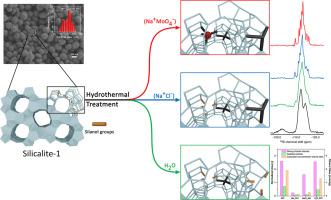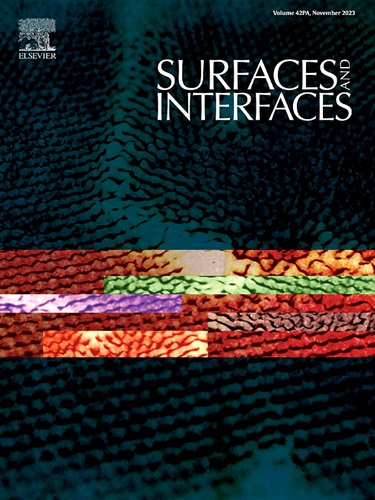通过受控合成后水热处理阐明 MFI 纳米沸石中的硅醇去除作用
IF 6.3
2区 材料科学
Q2 CHEMISTRY, PHYSICAL
引用次数: 0
摘要
合理控制硅醇基团仍然是沸石合成中一个难以实现的梦想。为了加深对这一现象的理解,我们使用钼酸钠、氯化钠和超纯水对纳米级 Silicalite-1 进行了各种水热合成后处理,以评估硅醇含量的变化。经 X 射线衍射 (XRD) 证实,所有处理过的样品都出现了从正方晶到单斜晶的相变。傅立叶变换红外光谱(FTIR)和固态核磁共振(NMR)光谱显示,后处理样品中硅醇基团的浓度有所下降。与母体硅灰石-1 相比,用钼酸钠处理可去除约 98% 的硅醇基团,而用氯化钠和超纯水处理的样品则分别减少了 90% 和 20%。此外,吡啶吸附后的傅立叶变换红外光谱结果表明,母体硅灰石-1 和 H2O 硅灰石-1 样品含有大量缺陷,分别需要 13.55 和 11.18 μmol 才能使所有非对称桥接位达到饱和,而用氯化钠处理的样品只需要 1.07 μmol 就能使所有硅氧烷位达到饱和。相比之下,用钼酸钠处理的沸石无缺陷。研究发现,钼通过插入沸石框架有助于去除弱和强氢键硅烷醇基团,而钠则在沸石框架内缩合开放桥和去除较弱和较强氢键硅烷醇基团方面发挥了重要作用。硅醇基团的缩合似乎是由于硅醇基团在 Na+ 存在下的极化促进了硅氧基团的形成,而硅氧基团最终很容易与相邻的 SiOH 基团缩合,在样品的活化过程中释放出水分子。本文章由计算机程序翻译,如有差异,请以英文原文为准。

Elucidating silanol removal in MFI nanosized zeolites through controlled post-synthesis hydrothermal treatments
The rational control of silanol groups is still an elusive dream in zeolite synthesis. To enhance our understanding of this phenomenon, we have performed various hydrothermal post-synthesis treatments on nanosized Silicalite-1 using sodium molybdate, sodium chloride, and ultrapure water to evaluate the alteration of silanol content. All treated samples exhibited a phase transition from orthorhombic to monoclinic confirmed by X-ray diffraction (XRD). Fourier-Transform Infrared (FTIR) and solid-state Nuclear Magnetic Resonance (NMR) spectroscopy showed a decrease in the concentration of silanol groups in the post treated samples. The treatment with sodium molybdate leads to the removal of approximately 98% of the silanol groups, while the samples treated with sodium chloride and ultrapure water showed a decrease of 90% and 20% respectively, compared to the parent silicalite-1. Additionally, the results from pyridine adsorption followed by FTIR show that the Parent-Silicalite-1 and the H2O-Silicalite-1 samples contain a significant amount of defects, requiring 13.55 and 11.18 μmol, respectively, to saturate all the unsymmetrical bridging sites, while for the sample treated with sodium chloride only 1.07 µmol is needed to saturate all siloxane sites. In contrast, the treatment with sodium molybdate produced a free-defects zeolite. Molybdenum was found to contribute to the removal of both weak and strong hydrogen-bonded silanol groups through its insertion into the zeolite framework, while sodium played a significant role in condensing open bridges within the zeolite framework and removing less weak and strong hydrogen bonded silanol groups. This condensation of silanol groups seems to be facilitated by the polarization of silanol groups in presence of Na+ promoting the formation of siloxy groups that eventually condense easily with adjacent SiOH groups, liberating water molecules during the activation process of the samples.
求助全文
通过发布文献求助,成功后即可免费获取论文全文。
去求助
来源期刊

Surfaces and Interfaces
Chemistry-General Chemistry
CiteScore
8.50
自引率
6.50%
发文量
753
审稿时长
35 days
期刊介绍:
The aim of the journal is to provide a respectful outlet for ''sound science'' papers in all research areas on surfaces and interfaces. We define sound science papers as papers that describe new and well-executed research, but that do not necessarily provide brand new insights or are merely a description of research results.
Surfaces and Interfaces publishes research papers in all fields of surface science which may not always find the right home on first submission to our Elsevier sister journals (Applied Surface, Surface and Coatings Technology, Thin Solid Films)
 求助内容:
求助内容: 应助结果提醒方式:
应助结果提醒方式:


